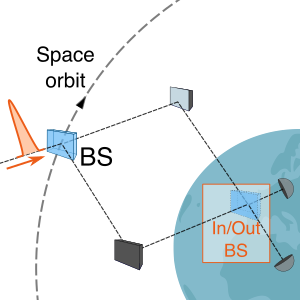
F. Vedovato1, C. Agnesi1, M. Schiavon1, D. Dequal1,2, L. Calderaro1, M. Tomasin1, D. G. Marangon1, A. Stanco1, V. Luceri3, G. Bianco2, G. Vallone1, P. Villoresi1
Science Advances 3, e1701180 (2017)
DOI:10.1126/sciadv.1701180
1Department of Information Engineering, University of Padova, via Gradenigo 6/B, 35131 Padova, Italy
2Matera Laser Ranging Observatory, Agenzia Spaziale Italiana, Matera 75100, Italy
3e-GEOS spa, Matera 75100, Italy
One of the most surprising and counterintuitive aspects of Quantum Mechanics is the wave-particle duality, more precisely the impossibility of describing the fundamental elements of nature exclusively as waves or as particles. In fact, Quantum Mechanics requires all elementary particles to be treated contemporaneously as waves and as particles, but forbids both characters to be observed simultaneously. In 1978 John Archibald Wheeler conceived a Gedankenexperiment, or thought-experiment, that takes the implications of Quantum Mechanics to the extreme, demonstrating that a classical description would lead to a seeming inversion of the normal order of time and thus a violation of the causality principle. Building upon the results of our research group in Satellite Quantum Communications and as part of the collaboration between the Matera Laser Ranging Observatory of the Italian Space Agency, we published a manuscript (Vedovato et al, Sci. Adv. 2017;3:e1701180) where we perform the first satellite version of Wheeler’s Gedankenexperiment. By exploiting the polarization degree of freedom and the temporal modes of photons reflected by satellites in a low Earth orbit, we demonstrated the necessity of the quantum treatment in the hostile space environment. Furthermore we have paved the way for further tests and applications of quantum theory in Space.
